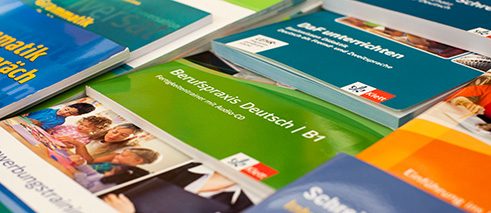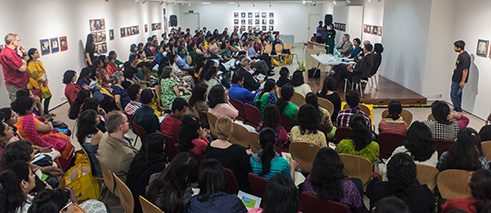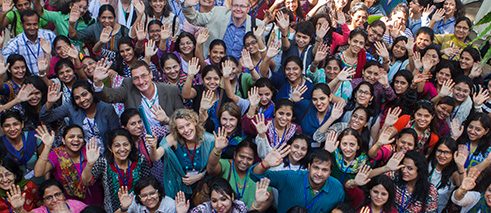DEUTSCH 3.0
German in India

Looking back and ahead: The series of events which marked the anniversary of “100 years of Teaching German in India” through the year 2014 drew to a close with DEUTSCH-3.0 on November 29 and 30 in Mumbai. The conference, at the end of which the baton would be carried forward to Berlin for the final event of DEUTSCH 3.0, was not so much retrospective in character but rather a dedicated glimpse forward.
At the joint invitation of the Goethe Institut/Max Mueller Bhavan, the University of Mumbai, and the Indo-German Teachers Association InDaF, German teachers, academics and representatives of Indian and German educational establishments and publishing houses not only discussed the current situation and future prospects of German learners and teachers in India but also acquired through workshops new impetus and inspiration for their language classes.
German(s) in India
It must be pointed out that the history of the German presence India dates back much longer than the “100 year Teaching German” that were celebrated this year. Bernhard Steinrücke, Director General of the Indo-German Chamber of Commerce reviewed in his welcome address of one and a half minutes not less than 300 years of Indo-German (linguistic) relationship: From Bartholomäus Ziegenbalg, who founded an Evangelical Lutheran congregation in 1707 in Tranquebar (now known as Tharangambadi), and who also made a name for himself as a linguistic researcher in the Indian languages of Tamil, Kannada and Telugu, to Hermann Gundert, who came to India 150 years ago and studied the South Indian language Malayalam. He also spoke about the Indologist Max Müller, whose research interests, among others, focused on Sanskrit and whose name is today a part of the name of the Goethe-Institut in India.The enthusiasm expressed by Steinrücke was reflected in the inaugural address by Hermann Funk from the University of Jena, who spoke about the “principles and standards of a good language class”, as well as in the presentation by Philipp Haußmann and Elizabeth Webster from Ernst Klett publishing house addressing the background and criteria in developing current teaching material at their institution. The moderated panel discussion on “Development of Quality Standards and Quality Control of German language lessons” by Prof. Hans-Jürgen Krumm from the University of Vienna was quick to convince the audience that it was worth having come to Mumbai for the event.
Growing demand
 Teaching material
| Photo: Goethe-Institut / Max Mueller Bhavan New Delhi
While German universities are, in the course of internationalization, converting more and more (Masters) courses of studies to English, more and more Indians are learning German. Many of them learn it with the aim of studying there. As per the statistics of the German Academic Exchange Service (DAAD), there were 5745 Indian students studying in Germany in 2012, in the winter semester of 2013/2014 the number stood at 9616.
Teaching material
| Photo: Goethe-Institut / Max Mueller Bhavan New Delhi
While German universities are, in the course of internationalization, converting more and more (Masters) courses of studies to English, more and more Indians are learning German. Many of them learn it with the aim of studying there. As per the statistics of the German Academic Exchange Service (DAAD), there were 5745 Indian students studying in Germany in 2012, in the winter semester of 2013/2014 the number stood at 9616.“The rapidly rising interest in the German language in India suggests that it is not only necessary to look back at the past years but also look ahead primarily to the question of how to continue further,” said Alicia Padrós of Goethe-Institut/Max Mueller Bhavan New Delhi, whose initiative it was to conceptualize the conference as a part of the DEUTSCH-3.0 project as well as to select Mumbai as the venue. Beata Weber, who along with her team at Goethe-Institut/Max Mueller Bhavan Mumbai organized the event said, “It was particularly important that the German Language Department of the University of Mumbai and the Indo-German Teachers Association InDaF were brought in as partners for the conference for we have collaborated with them for long and we wish to continue working closely together.” Markus Biechele, Head of the Language Department of the Goethe-Institut in South Asia explained, “In the light of the continuously increasing demand for German language lessons in India, it is now more important than ever that we create a synergy between the different participants of the German language training programmes.”
“German in 1,000 schools”
The increasing popularity of the German language in India is further evident from the increased number of courses on offer in private schools and the Goethe-Institutes in the country, which have witnessed a rising interest in their language courses over the years. The public schools are also reacting to the rising demand.After a pilot phase in 2009, school children in several schools of the state-run education establishment Kendriya Vidyalaya Sangathan (KVS), in which primarily children of government employees learn, have been able to choose since 2011 German as the third language after the national languages Hindi and English. As of 2014 almost 80,000 children in 500 schools have availed of this offer. A total of 1,10,000 children in Indian secondary schools alone are currently learning German.
Inspiring Workshops and spirited discussions
The conference weekend in Mumbai was fully packed with interesting lectures, inspiring workshops and spirited discussions on general and specialized subjects. In the break one had the opportunity to get suggestions for one’s own work at the book exhibition and information booths of the leading publishers of German as Foreign Language books like Klett-Langenscheidt, Cornelsen and Hueber as well as the Indian foreign language publisher Goyal. There were also presentations, e.g. on the “OnLeihe” online-library of the Goethe-Institut). At the DAAD stand one could get information about scholarships and study opportunities in Germany. The 22 workshops in total covered a wide range of topics centred upon learning and teaching German as a foreign language, from new insights on the neuro-didactic principles of learning, use of short films, literature, music and theatrical performance exercises in class to questions on the German and Austrian cultural studies and of best practice examples.“Multilingualism makes one clever”
 Interesting lectures
| Photo: Goethe-Institut / Max Mueller Bhavan New Delhi
Ursula Hirschfeld joined the congregated conference on the second day with her special subject lecture on “Pronunciation Standards and Pronunciation Differences in German”, enlivened by numerous and highly interesting audio examples. After another round of workshops everybody came together once more for a “Indo-German Dialogue” entitled “Language competition or multilingualism”. Dr. Pramod Talgeri and Prof. Hans-Jürgen Krumm put forth some fundamental thoughts on the role of the German language in a multilingual world”. There is hardly a better place imaginable to discuss this topic than the megacity of Mumbai, where more languages are spoken side by side than in any other metropolis in the world.
Interesting lectures
| Photo: Goethe-Institut / Max Mueller Bhavan New Delhi
Ursula Hirschfeld joined the congregated conference on the second day with her special subject lecture on “Pronunciation Standards and Pronunciation Differences in German”, enlivened by numerous and highly interesting audio examples. After another round of workshops everybody came together once more for a “Indo-German Dialogue” entitled “Language competition or multilingualism”. Dr. Pramod Talgeri and Prof. Hans-Jürgen Krumm put forth some fundamental thoughts on the role of the German language in a multilingual world”. There is hardly a better place imaginable to discuss this topic than the megacity of Mumbai, where more languages are spoken side by side than in any other metropolis in the world.According to Talgeri, since the 1950s in India Hindi is “the language of the freedom struggle” and the upkeep of the other regional languages since this time has been a project linked with a strategy for national integration. This includes the “three language formula” which has since that time governed the national language curriculum of schools. Accordingly, after the official national language Hindi and the equally important “additional official language” English (valued highly in communications) a free choice of any Indian language is ensured as a third language.
But in his opinion it is rather short-sighted on part of government schools to abide strictly by such a rule. The underlying hidden apprehension that the use of a foreign language “could lead to losing the national identity” is unfounded. The orientation of younger Indians towards German or other foreign languages such as Spanish, French or even Mandarin threatens neither the national language nor the identity of India. It is rather an expression of open-mindedness towards the world and the economic awakening of India, which a country can be rightfully proud of.
And how does the much-lauded ideal of multilingualism work in Europa? asked Talgeri. Hans-Juergen Krumm replied, one notices in Europe an ambivalence of sorts towards multilingualism. On the one hand one values the “elite-multilingualism” in economics and science (where, however, a questionable and rather short-sighted trend towards English-monolingualism can be observed), on the other hand one turns up one’s nose at the “multilingualism of the poor”, of the immigrants and the refugees. But these languages must also be learned in order to gain cultural and intellectual enrichment. As a general principle: “Multilingualism makes one clever”.
Talgeri agreed explicitly to that and referred to an interesting trend, which he had observed on Indian radio programmes. In such programmes several languages are often used side by side and mixed together, “a type of linguistic hybridism”, which enables the listeners to recognize incidentally new facets of contextual importance.
An all round successful conclusion
 Perfect conclusion
| Photo: Goethe-Institut / Max Mueller Bhavan New Delhi
The symposium in Mumbai had everything. The intensive two-day programme followed a clever plot and traced once again, far away from Germany, the entire spectrum of questions of the past eleven months of DEUTSCH 3.0. In the workshops and the many incidental talks not only all conceivable facets and perspectives of the German language teaching were brought to light, but also the importance of language(s) for culture, economy and society was discussed. And the supporting cultural programmes, including a reading by the author Leonard Thoma from his short story collection “Das Idealpaar” (“The Ideal Pair”), which has been conceptualized for German language lessons, and a performance by the Indian musician Krishna Marathe, set the right tone. As part of the anniversary celebrations of the “100 Years of Teaching German in India” there will be one more conference at the University of Mumbai. For DEUTSCH 3.0 this was indeed a successful end.
Perfect conclusion
| Photo: Goethe-Institut / Max Mueller Bhavan New Delhi
The symposium in Mumbai had everything. The intensive two-day programme followed a clever plot and traced once again, far away from Germany, the entire spectrum of questions of the past eleven months of DEUTSCH 3.0. In the workshops and the many incidental talks not only all conceivable facets and perspectives of the German language teaching were brought to light, but also the importance of language(s) for culture, economy and society was discussed. And the supporting cultural programmes, including a reading by the author Leonard Thoma from his short story collection “Das Idealpaar” (“The Ideal Pair”), which has been conceptualized for German language lessons, and a performance by the Indian musician Krishna Marathe, set the right tone. As part of the anniversary celebrations of the “100 Years of Teaching German in India” there will be one more conference at the University of Mumbai. For DEUTSCH 3.0 this was indeed a successful end.